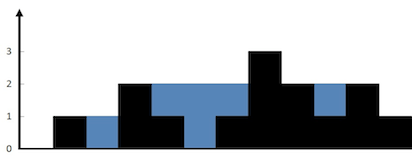Given n non-negative integers representing an elevation map where the width of each bar is 1, compute how much water it is able to trap after raining.
For example,
Given [0,1,0,2,1,0,1,3,2,1,2,1], return 6.

The above elevation map is represented by array [0,1,0,2,1,0,1,3,2,1,2,1]. In this case, 6 units of rain water (blue section) are being trapped. Thanks Marcos for contributing this image!
问题: 给定一个数组,每个元素表示海报高度,每个元素宽度均为 1 ,求这个数组能装多少雨水。
虽然这道题属于 two pointers 类型,不过我是用借助队列来解的。
可能是因为之前做过直方图相关的题目Largest Rectangle in Histogram ,这道题做起来感觉思路挺顺畅。将数组的值称为泥土体积。
- 对于从左往右的递增区间,装满雨水后的总体积 - 该区间的总泥土体积 = 该区间的总雨水
- 对于剩余的从右往左的递增区间,同样地,装满雨水后的总体积 - 该区间的总泥土体积 = 该区间的总雨水
对于题目中的例子而言,从左往右的递增区间是 [0,1,0,2,1,0,1,3 ], 剩余的从右往左的递增区间是 [ 3,2,1,2,1]。
class place{ public: int idx; int height; place(int idx, int height){ this->idx = idx; this->height = height; } }; int trap(vector<int>& height) { if(height.size() == 0){ return 0; } // 计算从左往右的递增区间 queue<place*> qL; place* tmpp = new place(0, height[0]); qL.push(tmpp); for (int i = 1; i < height.size(); i++) { if (height[i] >= qL.back()->height) { place* tmpp = new place(i, height[i]); qL.push(tmpp); } } int totalRectL = 0; while (qL.size() > 1 ) { place* tmpp = qL.front(); qL.pop(); int len = qL.front()->idx - tmpp->idx; totalRectL += (tmpp->height * len); } place* heighestL = qL.front(); qL.pop(); int earthAmtL = 0 ; for (int i = 0 ; i < heighestL->idx; i++) { earthAmtL += height[i]; } int waterL = totalRectL - earthAmtL; // 计算剩余的从右往左的递增区间 queue<place*> qR; tmpp = new place((int)height.size()-1,height[height.size()-1]); qR.push(tmpp); for (int i = (int)height.size()-2; i >= heighestL->idx; i--) { if (height[i] >= qR.back()->height) { tmpp = new place(i, height[i]); qR.push(tmpp); } } int rectR = 0; while (qR.size() > 1) { place* tmpp = qR.front(); qR.pop(); int len = tmpp->idx - qR.front()->idx; rectR += tmpp->height * len; } place* heighestR = qR.front(); qR.pop(); int earthAmtR = 0; for (int i = (int)height.size()-1; heighestR->idx < i ; i--) { earthAmtR += height[i]; } int waterR = rectR - earthAmtR; int res = waterL + waterR; return res; }